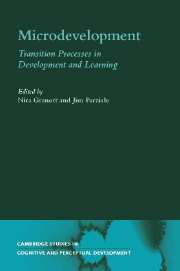Book contents
- Frontmatter
- Contents
- List of figures
- List of tables
- List of contributors
- Microdevelopment: A process-oriented perspective for studying development and learning
- Part I Variability
- Part II Transition mechanisms
- Part III Micro- and macrodevelopment
- Part IV Context
- 10 Notebooks as windows on learning: The case of a science-into-ESL program
- 11 Darwin's construction of the theory of evolution: Microdevelopment of explanations of variation and change in species
- 12 Developmental dynamics, intentional action, and fuzzy sets
- Author index
- Subject index
- References
10 - Notebooks as windows on learning: The case of a science-into-ESL program
Published online by Cambridge University Press: 22 September 2009
- Frontmatter
- Contents
- List of figures
- List of tables
- List of contributors
- Microdevelopment: A process-oriented perspective for studying development and learning
- Part I Variability
- Part II Transition mechanisms
- Part III Micro- and macrodevelopment
- Part IV Context
- 10 Notebooks as windows on learning: The case of a science-into-ESL program
- 11 Darwin's construction of the theory of evolution: Microdevelopment of explanations of variation and change in species
- 12 Developmental dynamics, intentional action, and fuzzy sets
- Author index
- Subject index
- References
Summary
Introduction
Our efforts to study the acquisition of new knowledge, especially in the areas of mathematics and science, take advantage of a combination of methods. These include experiments, controlled training studies, and qualitative analyses of videotaped classroom learning. In addition, we have been developing ways to treat the classroom as an in situ learning laboratory. Here we focus on a particular example, a science-into-ESL (English as a Second Language) classroom that functioned as a concept and language learning laboratory.
A key research goal was to gather “on-line” data on whether students moved on to and along relevant learning paths during the course of a semester. Given the classroom setting, we wanted these to be inconspicuous “probes” rather than more traditional learning test trials. Our solution shares important aspects of the microgenetic method, the topic of this book. We requested that students keep notebooks and make regular entries that could function as learning experiences for them and probes as to whether learning was happening over time. Notebook entries are a common feature of how scientists work, especially when it comes to trying to keep track of experiments and evolving ideas. They also have served historians of science as documents for analyzing the conditions of conceptual change. As we shall see, notebooks have the potential to serve researchers' efforts to obtain on-line information about students' progress in a non-intrusive manner.
- Type
- Chapter
- Information
- MicrodevelopmentTransition Processes in Development and Learning, pp. 269 - 293Publisher: Cambridge University PressPrint publication year: 2002
References
- 8
- Cited by



